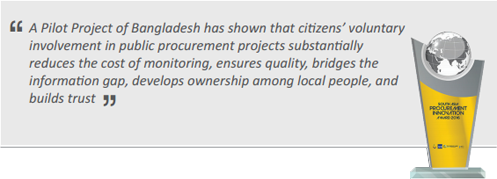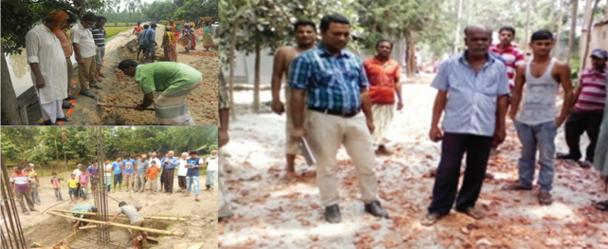Feature Stories
- How Bangladesh bridged the gap between amateur and professional in government procurement
- Rated Criteria: Promoting Value in World Bank Procurement
- Public Procurement Transformation in Bangladesh
- Achievement of Value for Money and Enhancement of Efficiency, Economy and Transparency in Procurement - Document Archive System
Archives
- End-to-End Procurement Planning and Maintenance System Integrated with Project MIS
- Application of Construction Milestones in Rural Road Contracts of Nepal
- Gross National Happiness Model for Pursuing Sustainable Public Procurement
- Government procurement is the basis of wide opportunities for enterprise development
- The Challenges of Procurement Training in a Fragile Country: the Afghanistan Experience
- When and How to Open Contracts: Transparency and Engagement through World Bank Projects
- Innovations and Best Practices in Procurement Processes of Disaster Recovery Projects
- World Bank Experts Discuss Global Procurement Trends and Armenia's e-GP system with the National Assembly
- Technology driving transparent and accountable public procurement reform in Bangladesh
- Prototype for Implementation of Framework Agreement via Blockchain
- Construction Project Planning and Management Capacity Building in India: A Wholistic Approach to Boost Infrastructure Development
- Zimbabwe: Public Procurement reform to catalyze greater transparency and development
- 15th Procurement, Integrity, Management and Openness (PRIMO) Forum
- e-Procurement World Map
- Preventing and controlling corruption: A modern approach to Procurement
- 6th South Asia Public Procurement Conference held in Thimphu, Bhutan
- South Asia Procurement Innovation Awards 2018 Announced
- Procurement iNET completes 5 years and new CPPP Fastest 100% Challenge Launched
- Risky Business: Does Debarring Poor Performers Mitigate Future Performance Risk?
- Global Procurement Summit 2019, New Delhi, India
- World Bank India launches Survey for International Civil Works Contractors
- World Bank launches new Complaints Module in Systematic Tracking of Exchanges in Procurement (STEP) System
- New Open Contracting Data Standard for e-Procurement Systems Launched
- Bangladesh's success in public procurement: Sustained reform really pays off
- The five drivers for improving public sector performance: Lessons from the new World Bank Global Report
- South Asia Public Procurement Innovation Awards 2018
- Conversation with Khaled Elarbi, President, High Authority for Public Procurement (HAICOP), Tunisia on the Digitalization of Public Procurement
- Breaking the glass ceiling in Africa: Rwanda E-Government Procurement System
- How government e-marketplace is revolutionizing procurement in India
- Ensuring Value for Money in Infrastructure Projects - The Botswana way
- Blockchain Lessons for Procurement
- Botswana’s Benevolent Move to Enhance its Procurement Profession
- Achieving Better Value for Money Using e-Auction for Procurement of Goods by Public Sector - A Success Case from DPDC
- Guide to Project Management and Contract Management (GPMCM) – New Approach to Improve Efficiency and Effectiveness of Procurement Outcomes
- Regional Winners of SAPIA 2017 participate in 8th International Public Procurement Conference (IPPC 8) Arusha, Tanzania
- The Future of Public Procurement in the Era of Digitalization
- World Bank Operations Procurement Helping Turkey to Procure a US$2 Billion Gas Storage Facility
- Unlocking Energy Efficiency Market in India - Through Innovative Procurement Business Model
- Getting value for money: Creating an automated market place for farmers in Pakistan
- Towards a Single Market for Public Procurement in Caribbean Small States
- Web-Based Online Evaluation Tool (e-Tool) for Procurement of Works by Royal Government of Bhutan
- Strengthening Health Sector Procurement System Offer Hopes for Universal Health Coverage in Nepal
- Morocco makes Strides in Modernizing its Public Procurement System— Operationalization of the Procurement Regulatory Body
- Innovations in Procurement Process and Selection that Lead to Improved Outcomes – Tenderers’ Database Management System
- Looking Back and Forward: The World Bank’s Procurement Framework
- Independent Monitoring and Evaluation of Contracted Health Services Leads to Improved Outcomes in Rural Areas of Afghanistan
- Fifth South Asia Region Public Procurement Conference brings focus on Procurement in Public Service Delivery
- 12 Procurement Innovations from South Asian Countries Celebrated
- Social Media is Improving Procurement in Lao PDR
- ASEAN meeting explores ways of professionalizing public procurement to meet development challenges
- Second International Training Program on the World Bank’s New Procurement Framework
- South Asia Procurement Innovations Award 2017 launched with Bigger and Better Prizes
- How to bid, finding opportunities, what makes a successful bid
- Pushing boundaries in procurement framework implementation
- Experience of Developing PPSD for the Assam Agribusiness and Rural Transformation Project (APART), India
- An Electronic Approach: Streamlining Georgia's Procurement
- South Asia Heads of Procurement Knowledge Exchange Program to U.S. Government Procurement Systems started
- 13th Procurement, Integrity, Management and Openness (PRIMO) Forum - a Documentary
- Bangladesh to strengthen public procurement with World Bank supported Project
- Establishment of Technology-Based Health Procurement and Supply Chain Management System, and Capacity Development in Tamil Nadu Medical Services Corporation
- Towards a Single Market for Public Procurement in Caribbean Small States
- Redefining Procurement as an Innovative and Collaborative Centre of Excellence for Best-in-Class Sourcing Solution
- India’s PowerGrid Endorsed for Alternative Procurement Arrangements by the World Bank
- Achieving Value for Money in Indonesia’s Geothermal Project
- Citizen Monitoring of Rural Roads Under Pradhan Mantri Gram Sadak Yojana (PMGSY), India
- Establishment of Grant and Service Contract Management Unit (GCMU) to Manage Contracting Out of Health Services in Afghanistan
- Procurement for Regional Development–Public Policy Initiative in Sri Lanka
- PPAF Community-Driven Development (CDD) Procurement Model, Pakistan
- Making Successful Procurement of IT Systems - An Experience from Vietnam
- Procurement Observatories continue to deliver in India
- Implementation of National e-GP System in Nepal
- Government e-Marketplace (GeM), India
- Africa High Level Public Procurement and Electronic Government Procurement Forums
- Development of Procurement Cadre as Part of Holistic Procurement Reforms in Bhutan
- Modernizing Public Procurement in Zimbabwe, one Step at a Time
- Citizen Engagement During Public Procurement Implementation in Bangladesh
- Winter 2017 Virtual Procurement, Integrity, Management, and Openness (PRIMO) Forum on Sanctions and Debarment Systems
- Close and Personalized Procurement Monitoring, Leading to Procurement Efficiency in Irrigation Sector in Fragile and Challenging Environments of Afghanistan
- Procurement Framework 2016 offers wider choices to ‘Go to Market’ based on PPSD
- Procurement Framework 2016 - Benefits, Status of Roll-out and M&E Arrangements
- PPSD offers Fit for Purpose Procurement Solutions
- Global Procurement Summit
- Fourth South Asia Region Public Procurement Conference
- The World Bank e-Procurement Tools
- South Asia Procurement Innovations Awards, 2016
- Learning Videos launched on STEP, online tracking tool on procurement for World Bank Projects
- Open e-Learning is Building a Cadre of Procurement Experts
- South Asia Region Public Procurement Conference, 2017
- Online Certificate Program in Public Procurement in Arabic Launched in Egypt
- First Procurement Knowledge Exchange Forum among ASEAN Countries
- Nobel Prize in Economics for contribution to Theory of Contract
- The Africa Region Harnesses Integrated e-Government Procurement (e-GP) Systems in Pursuit of Transparency and Integrity
- Procurement Reform for Humanitarian and Development Challenges in Kurdistan Region of Iraq (KRI)
- Successful Procurement is not just a set of Activities, it is a Strategy
- Afghanistan - Trends and Recent Developments in Governance
- PPSD is an Opportunity for clients and staff for Improved Procurement Management
- Procurement Reform Advances in the MENA Region
- Data Analysis and Collaborative Work in Action for Expedited Disbursements in Africa
- Ensuring Good Governance in Procurement in Sri Lanka
- New Procurement System to Improve Development Impact and Transparency in South Asia
- World Bank, USTDA Formalize Procurement Partnership
- How the New Procurement Framework Will Benefit 45.6 Million People in India
- Procuring the Future
- Reasons to Bid, Finding Business Opportunities
- New World Bank Procurement Framework Promotes Strengthened National Procurement Systems
- The readiness for Procurement Framework 2016
- 6 Things to know about New Procurement Framework
Citizen Engagement During Public Procurement Implementation in Bangladesh


{This article is an abridged version of the submission on “Citizen Engagement in Public Procurement Implementation in Bangladesh” made by Mr. Mirza Hassan, Social Accountability Consultant, PPRP II, BRAC Institute of Governance and Development, BRAC University, Dhaka, Bangladesh, for the South Asia Procurement Innovation Awards.}
Summary
A significant portion of the expenditure of Government of Bangladesh is on public procurement. Each year, Bangladesh spends more than BDT 72,000 Crores {USD 9 Billion (1 BDT = 0.013 USD)} on government procurement (Lomborg 2016). This huge investment, if not managed efficiently, can result in substandard output, cost overruns, and project implementation delays. Citizen engagement in public procurement can deter these by ensuring greater accountability and transparency, and consequently increase in quality of public goods and services. The challenge, however, is to devise a mechanism for citizen engagement that offers sustainability (in terms of cost efficiency) and potential replicability (in wider societal contexts).
Background
The Government of Bangladesh is currently implementing with World Bank financial assistance its Public Procurement Reform Project (PPRP) II, with project design, management, and research support from the BRAC Institute of Governance and Development (BIGD), BRAC University, Dhaka. One of the main focuses of this project is to successfully engage citizens in the monitoring of public procurement. For the purpose, BIGD has designed a citizen engagement strategy that includes establishment of a Citizen Committee, complemented by Local Community Mobilization surrounding the project sites. To identify and test which strategy, or rather, combination of strategies, produced the best results, BIGD implemented a Pilot Project in four Upazilas in two districts of Bangladesh: Rangpur and Sirajganj.

The project aimed at addressing a few major challenges at the implementation level. The first is improving the project quality (ensuring that appropriate materials and procedures are being used). Through close monitoring, Citizen Committee members and the Local Community attempted to ensure that quality specified in the contract is maintained. Another major challenge is reducing the transaction cost. Citizens’ voluntary involvement substantially reduces the cost of monitoring and also ensures quality.
Incentive / motivation problem of local people (sense of ownership over projects) is another major challenge, which is felt at the local level. As a result, project monitoring remains the responsibility of only government officers. The project utilized several strategies to reduce citizens’ lack of sense of ownership: it ensured supply of relevant information to the local people, made community aware of the importance of local monitoring and, most importantly, by acting on their feedback, ensured that the community felt engaged.

Even though similar projects are being implemented by engaging local citizens, the BIGD Pilot Project adds more to this aspect for a few reasons. Firstly, it includes two alternative designs of monitoring, which work simultaneously, reinforce each other, and also produce comparable results. By testing the two models together, this project gives great insights into the intervention, which can be very helpful for replication. While other projects in citizen engagement do not directly involve government authorities, the Pilot Project ensures effective participation of government officials. Since the beginning of the project monitoring, the Citizen Committee members maintained close coordination with engineers. This actually turned out to be a more effective mechanism than Citizen Committee acting as an independent actor. Citizen Committee members received updates of the project work from engineers and planned their visits at crucial stages of project. Contractors also took the committee visits seriously due to Citizen Committee’s affiliation with engineers.

Impact Generated
The project successfully addressed the challenges and ensured significant improvement in quality of the procurement process. The project had impact on all three stakeholders: citizens, government officials, and contractors, who were in charge of the implementation. The impact was by way of:
- Reduced information gap,
- Developing ownership among local people
- Information at low cost, and
- Trust
Of these, the most important impact is reduced information gap. The project made information available at the local level, which raised the interest of local people regarding the project. They learned about specifications and could oversee whether these were being met during the construction process. The project also successfully reduced the incentive problem of local people in relation to monitoring. By engaging people from the locality in monitoring by equipping them with information and technical details, along with briefing about the need of local ownership, the classic problem of free riding on public good was reduced. The project had a major impact by reducing the information cost. The local people and Citizen Committee members frequently visited project offices and reported anomalies to the engineer’s office. It thus solved monitoring-related transaction costs of the state agency significantly. Along with that, the engagement of citizens in monitoring reduced the need for frequent visits from Local Government Engineering Department (LGED) office, which also reduced the transaction costs.
Significant lack of trust among relevant actors is a major problem, which impedes transparent and efficient working of the project. Citizens do not trust contractors and contractors view citizens as opportunity seekers. Citizens also perceive engineers as corrupt and having a corrupt nexus with contractors. By engaging citizens in the monitoring process, the project was able to generate trust among all stakeholders. Contractors, when brought under group monitoring, were then trusted by the community. Since citizens are monitoring the projects based on specifications, contractors are compelled to follow the project specifications.

Scalability and Sustainability
One major concern of this project was to ensure its replicability in other regions and other projects. The simplicity of the design makes it easier to replicate it in other places and other projects. All it needs is commitment from government officials that they will motivate and engage local people to get involved in the monitoring. The cost is minimal, as it does not need any facilitation activities or travel. The model can also be replicable in any other context, any other country, or level. For example, if instead of villagelevel roads, the project includes a district-level road, all it needs to do is to inform more people living close to that highway. Government officials can hold public meetings at every few miles and provide people with necessary information to initiate a local monitoring system.
Pilot PPRP II project has already been tested in three different types of implementation of procurement process, such as road and school constructions, and textbook monitoring. The same citizen engagement model has worked in every case.


Substantial difference in response to citizen engagement has been noticed among government officials (engineers specifically) within the hierarchy. Executive engineers at the districts and upazilas provided considerable assistance by providing necessary information and guidance to the Committee Members. However, such assistance was difficult to obtain from the fieldlevel officials (sub-assistant engineers, supervisors etc). This was evident from their use of dilatory tactics in handing out the necessary documents to Citizen Groups or deliberately providing incorrect information regarding the status of the project. Further probing indicates that such avoidance and non-cooperation actually originated from their fear of losing control over the construction processes. The involvement of third-party actors in monitoring projects is viewed by them as interference by unwelcome external actors.
In this regard, one major learning of the project is to develop the strategy further to ensure better engagement of field-level government officials. The project tested two different methodologies – Monitoring Through Committee and Monitoring Through Local Citizens. The findings suggest that compared to the committee-based approach, monitoring through local citizens generates a more efficient result. Committee-based approach needs facilitation role from thirdparty actors to ensure group formation and group functionalities. It also involves travel cost and organizing cost.
It has been also felt that incentives of monitoring vary and in certain areas, citizen committees are more proactive compared to other areas. In such cases, sitespecific monitoring by local people seems a more plausible option compared to committee formation. It has near zero transaction cost, as no travel cost or thirdparty engagement is necessary, and ensures better ownership.
Another major learning of the project is that the citizen engagement process needs to be built into the official system. Government officials should start the initiative to engage local citizens effectively. Any third-party engagement would not be necessary then. Local people will get the information directly from officials and will report back to them. The project experience also suggests that to make citizens more engaged in the process, the feedback system should be strengthened. Grievance should be filed properly and it should be addressed properly. In such a case, a systematic complaint-filing mechanism needs to be developed, such as telephone hotlines or mobile messages. This way, local government officials can also be brought under monitoring and would feel accountable to act on the feedback they receive from citizens.
